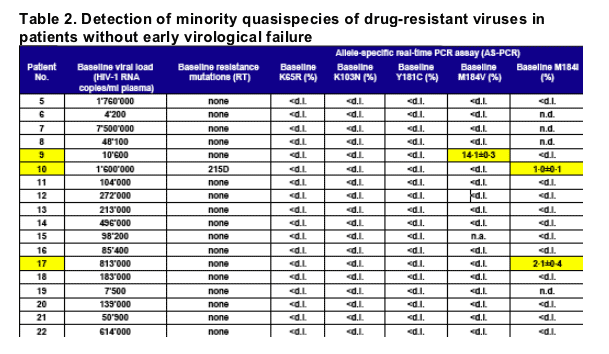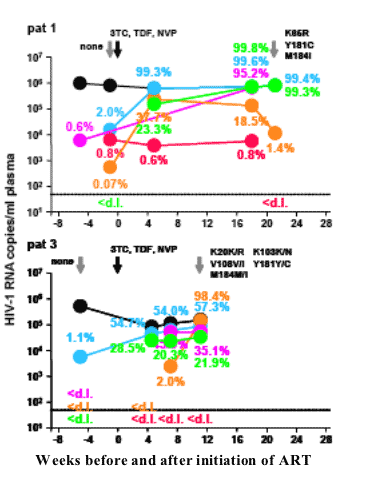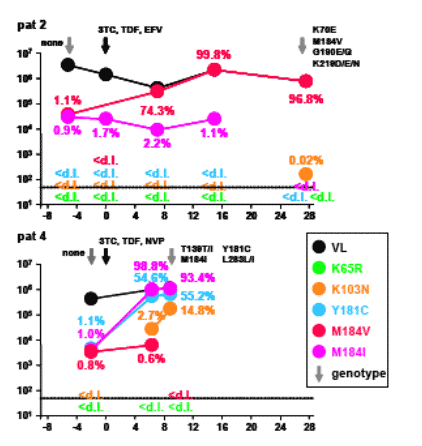 |
 |
 |
| |
Minority quasispecies of drug-resistant HIV-1 leading to early therapy failure in treatment-naive and adherent patients
|
| |
| |
Reported by Jules Levin
XVII HIV Drug Resistance Workshop
June 10-14, 2008
Sitges, Spain
From Jules: there was quite a bit of discussion at the workshop this year about using sensitive testing to identify low-level or minority genotypic resistance. At last year's Resistance Workshop the CDC and Mike Kozal from Yale reported in oral presentations that minority mutations can lead to viral failure. Concerns are how to translate these potential concerns into the clinic. There are some lingering concerns among a few that further confirmation is required before presuming that the presence of low-level mutations is a reliable test for not using a drug, despite several studies reporting that the risk for viral failure significantly increases if these mutations are present; but not everyone fails if minority mutations are present, so are you throwing out a good drug by avoiding it? Still the studies so far presented find there is a significantly increased risk of viral failure. Tests to screen for minority mutations are not clinically available yest, as far as I know. But there were several posters at this year's workshop presenting studies using tests. At last year's Workshop it was mentioned that Roche recently purchased the 454 test, and this was the subject of several posters at this year's meeting. The Roche test is expensive but a Roche person at the meeting and another researcher said there is a way o use the test that can reduce the costs significantly. This story will continue to develop I think as we continue to see researchers using various tests to identify minority mutations and correlate them with viral failure. The CDC will be publishing their study soon in PLoS, and these studies can be found on the NATAP website by using the search engine.
Stefano G. Giulieri (1), Stefanie A. Knoepfel (2), Pia Rauch (2), Philippe Burgisser (3), Sabine Yerly (4), Huldrych F. Gunthard (5), Matthias Cavassini (1), Karin J. Metzner (2)
(1) Infectious Diseases Service, University Hospital, Lausanne, Switzerland, (2) Institute of Clinical and Molecular Virology, University of Erlangen-Nuremberg, Germany, (3) Laboratory of Immunology and Allergy, University Hospital, Lausanne, Switzerland, (4) Laboratory of Virology, Geneva University Hospital and University of Geneva Medical School, Switzerland, (5) Department of Medicine, Division of Infectious Diseases and Hospital Epidemiology, University Hospital Zurich, Switzerland
"Sensitive assays for key mutations might be a useful tool before starting ART."
AUTHOR CONCLUSION
By using AS-PCR we show a rapid outgrow of minority quasispecies of drug- resistant viruses, undetected by conventional genotyping, leading to early virological failure despite excellent adherence.
There might be a clinical benefit for the detection of minority quasispecies of drug-resistant HIV-1 before starting ART in treatment-naive patients, especially in the context of treatments with low genetic barrier.
ABSTRACT
BACKGROUND: Early virological failure (eVF) of antiretroviral therapy (ART) associated with the selection of drug-resistant HIV-1 in treatment-naive patients is very critical, because it increases significantly the risk of subsequent failures. Thus, we evaluated the possible role of minority quasispecies of drug- resistant HIV-1, undetectable at baseline by population sequencing, in regard to eVF.
METHODS: We studied four patients with eVF on a first-line regimen of lamivudine, tenofovir, and either efavirenz or nevirapine, and 18 patients with similar treatment without virological failure. Adherence was controlled by measuring NNRTI plasma concentrations. The key mutations K65R, K103N, Y181C, M184V, and M184I within the reverse transcriptase were quantified by allele-specific real-time PCR performed blindly and retrospectively on plasma samples prior and during eVF.
RESULTS: None of the viruses prior to treatment showed any evidence of resistance in the genotypic analysis based on population sequencing. Minority quasispecies of either the M184V or the M184I mutation were detected in 3/18 control patients. In contrast, all four failing patients harbored drug- resistant viruses prior to treatment at low frequencies ranging from 0.07 to 2.0%. One to four mutations were detected in each patient. Most of them were rapidly selected and represented the major virus population within weeks after starting ART. All four patients showed good adherence. Two patients had directly observed therapy. NNRTI plasma concentrations were in normal ranges in all four patients on two separate time points.
CONCLUSIONS: Minority quasispecies of drug-resistant viruses detected at baseline can rapidly outgrow and represent the major virus population subsequently leading to early therapy failure. Sensitive assays for key mutations might be a useful tool before starting ART.
BACKGROUND
Because primary infection with a resistant strain may decrease the efficacy of initial therapy, resistance testing is routinely recommended before initiation of antiretroviral therapy. One major limitation of genotyping by population sequencing is the inability to detect drug-resistant minorities unless they represent 20-25% of the global population. By contrast, allele-specific real-time PCR (AS-PCR) allows the detection of minority quasispecies with discriminatory abilities as low as 0.01%. We evaluated the possible role of minority quasispecies of drug-resistant HIV-1, undetectable at baseline by population sequencing, in regard to virological failure.
METHODS
Patients :
Cases:
4 patients with early virological failure on a first-line regimen of lamivudine, tenofovir, and either efavirenz or nevirapine
No resistance mutations on baseline testing by population sequencing
Controls:
18 patients with similar clinical characteristics and same first-line treatment without virological failure
No resistance mutations on baseline testing by population sequencing
Analysis
Genotyping:
All patients had a baseline conventional genotyping by population sequencing before starting ART.
AS-PCR for the detection and quantification of minority quasispecies:
Blood samples: up to two samples prior to start of ART and all follow-up samples until start of second- line treatment for cases as well as one baseline sample of controls
The key mutations K65R, K103N, Y181C, M184V, and M184I within the reverse transcriptase were quantified.
RESULTS
Characteristics of patients with early virological failure within the first weeks after starting 1st ART (table 1)
All 4 patients were treatment-naive without resistance mutations on baseline genotypic testing. First-line regimen consisted of lamivudine, tenofovir and either nevirapine or efavirenz. Patient 3 switched to efavirenz after 8 weeks because of gastrointestinal side effects. Adherence was certified by directly observed therapy or weekly community visit by a qualified nurse. All patients had 2 or more measurements of NNRTI plasma concentration, which were in normal range.
Viral load remained > 100'000 copies/ml until the start of second-line tratment after 15-31 weeks. Patient 4 never had a viral load decrease during first-line treatment..

Patients without early virologic failure: characteristics and detection of minority quasispecies at baseline (table 2)
Of 18 control patients 5 were female, 10 belonged to HIV-1 subtype B. All patients suppressed viral replication to undetectable levels within 6-41 weeks on a first-line regimen of lamivudine, tenofovir and either efavirenz (17 patients) or nevirapine (1 patient).
Only 3 of 18 patients without virological failure harbored minority quasispecies of viruses carrying either the M184V or the M184I at baseline.

Rapid selection of minority quasispecies of drug-resistant viruses leading to early virological failure (figure 1)
1-4 drug resistance mutations were present as minority quasispecies at baseline in all 4 patients experiencing early virological failure. There was a significant difference in the frequency of detectable minority quasispecies of drug-resistant HIV-1 between cases and controls (4/4 vs. 3/18, p=0.005 on Fisher exact test)


|
| |
|
 |
 |
|
|